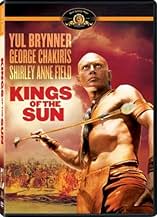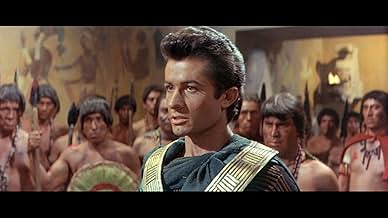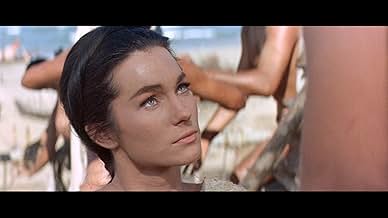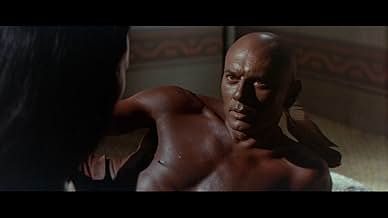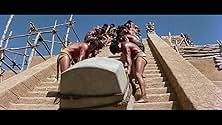CALIFICACIÓN DE IMDb
6.1/10
2.3 k
TU CALIFICACIÓN
En la costa del Golfo de México, la tribu nativa americana del jefe Águila Negra se enfrenta a la tribu maya del rey Balam.En la costa del Golfo de México, la tribu nativa americana del jefe Águila Negra se enfrenta a la tribu maya del rey Balam.En la costa del Golfo de México, la tribu nativa americana del jefe Águila Negra se enfrenta a la tribu maya del rey Balam.
- Dirección
- Guionistas
- Elenco
Victoria Vetri
- Ixzubin
- (as Victoria Vettri)
James Coburn
- Narrator
- (sin créditos)
Chuck Hayward
- Indian Warrior Friend to Black Eagle
- (sin créditos)
José Torvay
- Mayan Elder
- (sin créditos)
Opiniones destacadas
One major advance films have made since the "classic era" of the 1960s and before that, is in realism of characters. You don't see white people playing Asians or blacks or Indians anymore. When you do see it, in these old films, it now looks ludicrous and takes away from the seriousness of the movie.
Yul Brynner, however, is one guy who could get away with it. Here, he plays Mexican-Indian warrior "Chief Black Eagle" and he's believable. Whether it's his deep, menacing voice or bald head with striking feature, Yul was cool no matter role he played.
I can't say the same for the rest of the cast. The co-star, George Chakaris as "Balam (the ninth)" as the same pretty-boy hairstyle right out of the late '50s/early '60s; Richard Basehart ("Ah Min," a Mayan priest) has coloring on his face and wig you have to see to believe! Barry Morse ("Ah Zok") will forever be typecast as "Lt. Girard" the man who harassed for years TV's "The Fugitive." Meanwhile, there is film-TV-tough guy Leo Gordon as "Hunac Kell" and Shirley Anne Field as "Ixchel." Field is beautiful and looks the part, but a British accent in Mayan territory? However, as the film goes on, Field is more and more believable, for some reason.
Whatever, there's always the story and a nice widescreen print now out on DVD, which I was fortunate enough to obtain for rent. It was filmed in the Yucatan, so the scenery is real - not some studio back lot.
In the story, Balam's Mayans get pushed out of their area by a war-mongering neighbor, led by Kell. There is nowhere to escape except by water over the Gulf of Mexico. This was no easy feat back in these early days. They make it, start to build their new homes and civilization, only to run into the Indians who already reside nearby. They are led by Chief Black Eagle and he's not too friendly.
The rest of the film answers two big question: 1 - What will happen between the two groups? Will one annihilate the other, or can they live in peace? 2 - What if the old enemies - Hunac Kell's barbarians - show up? And......of course, the big question: who gets the girl?
Yul Brynner, however, is one guy who could get away with it. Here, he plays Mexican-Indian warrior "Chief Black Eagle" and he's believable. Whether it's his deep, menacing voice or bald head with striking feature, Yul was cool no matter role he played.
I can't say the same for the rest of the cast. The co-star, George Chakaris as "Balam (the ninth)" as the same pretty-boy hairstyle right out of the late '50s/early '60s; Richard Basehart ("Ah Min," a Mayan priest) has coloring on his face and wig you have to see to believe! Barry Morse ("Ah Zok") will forever be typecast as "Lt. Girard" the man who harassed for years TV's "The Fugitive." Meanwhile, there is film-TV-tough guy Leo Gordon as "Hunac Kell" and Shirley Anne Field as "Ixchel." Field is beautiful and looks the part, but a British accent in Mayan territory? However, as the film goes on, Field is more and more believable, for some reason.
Whatever, there's always the story and a nice widescreen print now out on DVD, which I was fortunate enough to obtain for rent. It was filmed in the Yucatan, so the scenery is real - not some studio back lot.
In the story, Balam's Mayans get pushed out of their area by a war-mongering neighbor, led by Kell. There is nowhere to escape except by water over the Gulf of Mexico. This was no easy feat back in these early days. They make it, start to build their new homes and civilization, only to run into the Indians who already reside nearby. They are led by Chief Black Eagle and he's not too friendly.
The rest of the film answers two big question: 1 - What will happen between the two groups? Will one annihilate the other, or can they live in peace? 2 - What if the old enemies - Hunac Kell's barbarians - show up? And......of course, the big question: who gets the girl?
Anyone interested in seeing Hollywood's version of the Maya should view this noted 60's entry. The film is punctuated with panoramic locations, magnificent sceneries and considerable numerical extras for sustained blockbuster effect. Entittled, " The Kings of the Sun ", this film is a worthy offering to entertain young and old alike. Assembled for the cast are Yul Brynner as Chief Black Eagle, George Chakiris as a Mayan Chiefton, Richard Basehart as a Mayan Priest and Shirley Anne Field as Ixchel, a beautiful princess. Accompanying this artistic rendering is it's rousing, nearly overpowering musical score composed by legendary Elmer Bernstine. The film depicts the story of a Mayan people amid its cultural throes in which Chakiris, replaces their dying king, but is forced to flee by a deadly rival menacingly played by Leo Gordon. Commandering an entire peaceful Mayan tribe on the hinterland of the Yucatan and sailing to the shores of America, Chakiris not only establishes a new beginning for his following, but collides culturally with Brenner and his Native American tribe. Aside from Eviserating cultural traditions, pummeling ancient deities and perhaps trampling on the Historical record, the film events are nevertheless worthy of tongue in cheek possibility. In the end, one can smile happily at this wonderful attempt and praise it for its dramatic sincerity. **** .
The Mayas, one of the most mysterious and interesting civilizations that the world has ever seen, have not been popular movie heroes in cinema history. Except for Mel Gibson who recently directed APOCALYPTO, a stunning picture showing the twilight of the Mayan kingdom, not many people know that there was also J. Lee Thompson before who made KINGS OF THE SUN. He directed it in the early 1960s and, as a result, the film is filled with its era, with the style of the 1960s film-making. The reason why this movie is short of popularity is its highly limited access, not many TVs broadcast it, in most stores it is entirely skipped. Yet, recently, I had a chance to see KINGS OF THE SUN on Polish TV. And how did I feel about it? At first, I said to my friend who gave it a viewing with me: Nice little movie" but after the second viewing, I noticed something captivating in it, I began to like it.
It is so because of entire different reasons than in case of APOCALYPTO. I don't like the idea to compare these two movies because they are totally different. What KINGS OF THE SUN lacks APOCALYPTO has and vice versa, including authenticity of language, cinematography, performances and music. The major reason why I was stunned by KINGS OF THE SUN is the presence of Yul Brynner. He is terrific as Black Eagle, a heroic chief of the Indian tribe who, at first, is hostile towards the new invaders; consequently, he is to be sacrificed to the God of Waters, and finally, finds himself in the absolutely unexpected circumstances. Brynner had many roles that were great but whoever claims that it is one of his very best ones is right. The way he says to Balam Your woman is beautiful" enthralled me. The moment he observes a peculiar new city from a high tree remained in my memory as exceptionally outstanding. The final sequence is supplied with emotions also thanks to him. I admit that other cast do fine jobs, including George Chakiris as king Balam and Richard Basehart as priest Ah Min, but Brynner absolutely rocks. While he was the king in THE KING AND I, he is "the king of KINGS OF THE SUN."
The pure film factors like cinematography, direction, editing are quite fine here, yet, they are not top notch. Perhaps, that is the reason why the movie has not become one of the top movies of the genre like other films of the time. But one thing is important to mention: it is a pure adventure, not an epic but the fictitious nice little story of love, courage, fight for independence, coping with social problems, building up a new life in a new place. The character of Balam is well developed he is the King for his people, the one who says NO" to the fanatical religion and the insane idea of human sacrifice. His final speech is pretty thought provoking What do gods really want of us? What sort of sacrifice?" Yet, nothing draws your attention to profoundity or history - all is there around adventure goal, like in other films of the time, including THE VIKINGS (1958) by Richard Fleischer or THE LONG SHIPS (1964) by Jack Cardiff. Pity that these two cultures, the Vikings and the Mayas, have not been put on screen more often in purely historical films while there are much more educational films about Rome, Egypt or Greece. But that is a different story. KINGS OF THE SUN, for entertainment's sake, is really a rousing adventure.
The last interesting aspect of the movie I'd like to mention is its musical score which is really memorable, not very easy to tune but fits well to the scenes and the entire spirit of the movie. Music is affected by adventure, fighting, emotion... all that leaves an impact in the viewer. Consider, for instance, the rapid tunes interrupted by gentle ones when Ixchel (Shirley Anne Field) is trying to tame" the Black Eagle. Another wonderful musical moment is when they sail on the sea, the whole picture is stunning. It is so thanks to cinematography, authentic locations, including popular pyramid of Chichen Itza, but music adds much as well.
I have a fresh memory of this movie since I have seen it recently. The case with you may be different, perhaps it has faded in your memory due to many years that have passed since you last saw it. Maybe, it is the first time you have heard of this movie. But I give you my honest advice, look for it because it is really worth seeing. Whether KINGS OF THE SUN is going to be released on DVD or not, it is absolutely worth seeking out. Doesn't have the power of APOCALYPTO, doesn't offer the authentic use of languages as well as native cast, yet, Brynner will leave you breathless and some other aspects will unexpectedly satisfy you. 7/10
It is so because of entire different reasons than in case of APOCALYPTO. I don't like the idea to compare these two movies because they are totally different. What KINGS OF THE SUN lacks APOCALYPTO has and vice versa, including authenticity of language, cinematography, performances and music. The major reason why I was stunned by KINGS OF THE SUN is the presence of Yul Brynner. He is terrific as Black Eagle, a heroic chief of the Indian tribe who, at first, is hostile towards the new invaders; consequently, he is to be sacrificed to the God of Waters, and finally, finds himself in the absolutely unexpected circumstances. Brynner had many roles that were great but whoever claims that it is one of his very best ones is right. The way he says to Balam Your woman is beautiful" enthralled me. The moment he observes a peculiar new city from a high tree remained in my memory as exceptionally outstanding. The final sequence is supplied with emotions also thanks to him. I admit that other cast do fine jobs, including George Chakiris as king Balam and Richard Basehart as priest Ah Min, but Brynner absolutely rocks. While he was the king in THE KING AND I, he is "the king of KINGS OF THE SUN."
The pure film factors like cinematography, direction, editing are quite fine here, yet, they are not top notch. Perhaps, that is the reason why the movie has not become one of the top movies of the genre like other films of the time. But one thing is important to mention: it is a pure adventure, not an epic but the fictitious nice little story of love, courage, fight for independence, coping with social problems, building up a new life in a new place. The character of Balam is well developed he is the King for his people, the one who says NO" to the fanatical religion and the insane idea of human sacrifice. His final speech is pretty thought provoking What do gods really want of us? What sort of sacrifice?" Yet, nothing draws your attention to profoundity or history - all is there around adventure goal, like in other films of the time, including THE VIKINGS (1958) by Richard Fleischer or THE LONG SHIPS (1964) by Jack Cardiff. Pity that these two cultures, the Vikings and the Mayas, have not been put on screen more often in purely historical films while there are much more educational films about Rome, Egypt or Greece. But that is a different story. KINGS OF THE SUN, for entertainment's sake, is really a rousing adventure.
The last interesting aspect of the movie I'd like to mention is its musical score which is really memorable, not very easy to tune but fits well to the scenes and the entire spirit of the movie. Music is affected by adventure, fighting, emotion... all that leaves an impact in the viewer. Consider, for instance, the rapid tunes interrupted by gentle ones when Ixchel (Shirley Anne Field) is trying to tame" the Black Eagle. Another wonderful musical moment is when they sail on the sea, the whole picture is stunning. It is so thanks to cinematography, authentic locations, including popular pyramid of Chichen Itza, but music adds much as well.
I have a fresh memory of this movie since I have seen it recently. The case with you may be different, perhaps it has faded in your memory due to many years that have passed since you last saw it. Maybe, it is the first time you have heard of this movie. But I give you my honest advice, look for it because it is really worth seeing. Whether KINGS OF THE SUN is going to be released on DVD or not, it is absolutely worth seeking out. Doesn't have the power of APOCALYPTO, doesn't offer the authentic use of languages as well as native cast, yet, Brynner will leave you breathless and some other aspects will unexpectedly satisfy you. 7/10
"Kings of the Sun" is a highly fictionalized story about the Mayan civilization of central America. The story has one of the last remaining Mayan groups fleeing to save their civilization. The Mayans were spread across much of modern day southern Mexico into other Central American countries. Others of their groups had been attacked and wiped out or conquered by an invading warring nation. We see clearly the distinction between the advanced civilization of the Mayans and the barbaric nature of their attackers. The movie doesn't give us a date or time frame, so it might have been any time in the latter Mayan period (100 to 700 A.D.). This was all well in advance of European discovery.
Many viewers today may not find this movie very interesting or entertaining. It is slow, for sure. There was considerable interest in ancient civilizations around the mid-20th century. And, a host of movies like this were made back then. Today we know more about the ancients, and Western interests for the most part seem to have shifted to the stars, space and the distant future. The fiction of the story here is only slightly interesting. The script isn't that good. Yul Bryner is probably the only good acting job, as Black Eagle. The rest of the cast are just so-so.
This movie has a number of conflicts with history. One has the invaders with iron weapons against the Mayans' wooden swords. In fact, there is little evidence of metal discoveries and development in the Americas. Only toward the middle of the second millennium is there some scant appearance of bronze objects. But, iron and steel appear only with the Europeans in the 16th century. That struck me as a strange thing that would belie history as well. If the Mayans were so advanced, and an agricultural society, why had they not discovered bronze or iron with which to make plows and other farming implements and tools? They hadn't yet in this movie, but the barbaric invaders had iron swords.
I note some of the reviews and correction comments that take issue with the Indian dress and tepees of Yul Bryner's tribe. But, I don't see or recall anything in the film that says the Mayans landed near the Mississippi Delta. The only evidence of any stream is a very small one. And, the vegetation that we see – trees and underbrush don't resemble anything like the moss-covered forests of Louisiana and the Bayou country. That area is very moist with considerable rainfall. But, this film has the Mayans reaching land in a dry area. So, I suggest that they would have landed in southeast Texas. They might have landed anywhere from present-day Corpus Christi to north of Galveston. That would have put them close to the lower range of the Comanche Indians. The Comanche where a fierce warring and hunting tribe that ranged across the Plains from southern Nebraska to central Texas. And, they built and slept in tepees. If one looks at a map of Gulf of Mexico, it's clear to see that the Mayans could have left the Yucatan Peninsula and sailed "across the sea," landing in southeast Texas.
At one point in the film, Black Eagle says that his people can learn much from the Mayans, and that the Mayans can learn from them. The Mayans are not hunters but farmers. We see them build a dam on a creek to divert the water to irrigate their crops. Archaeologists decades ago found irrigation ditches that had been used by the Hopi Indians of Arizona nearly 2,000 years ago. Then, in 2009 near Tucson, scientists discovered more ancient irrigation canals. Those had been used by ancestors of the Hopi in 1,200 B.C.
Many viewers today may not find this movie very interesting or entertaining. It is slow, for sure. There was considerable interest in ancient civilizations around the mid-20th century. And, a host of movies like this were made back then. Today we know more about the ancients, and Western interests for the most part seem to have shifted to the stars, space and the distant future. The fiction of the story here is only slightly interesting. The script isn't that good. Yul Bryner is probably the only good acting job, as Black Eagle. The rest of the cast are just so-so.
This movie has a number of conflicts with history. One has the invaders with iron weapons against the Mayans' wooden swords. In fact, there is little evidence of metal discoveries and development in the Americas. Only toward the middle of the second millennium is there some scant appearance of bronze objects. But, iron and steel appear only with the Europeans in the 16th century. That struck me as a strange thing that would belie history as well. If the Mayans were so advanced, and an agricultural society, why had they not discovered bronze or iron with which to make plows and other farming implements and tools? They hadn't yet in this movie, but the barbaric invaders had iron swords.
I note some of the reviews and correction comments that take issue with the Indian dress and tepees of Yul Bryner's tribe. But, I don't see or recall anything in the film that says the Mayans landed near the Mississippi Delta. The only evidence of any stream is a very small one. And, the vegetation that we see – trees and underbrush don't resemble anything like the moss-covered forests of Louisiana and the Bayou country. That area is very moist with considerable rainfall. But, this film has the Mayans reaching land in a dry area. So, I suggest that they would have landed in southeast Texas. They might have landed anywhere from present-day Corpus Christi to north of Galveston. That would have put them close to the lower range of the Comanche Indians. The Comanche where a fierce warring and hunting tribe that ranged across the Plains from southern Nebraska to central Texas. And, they built and slept in tepees. If one looks at a map of Gulf of Mexico, it's clear to see that the Mayans could have left the Yucatan Peninsula and sailed "across the sea," landing in southeast Texas.
At one point in the film, Black Eagle says that his people can learn much from the Mayans, and that the Mayans can learn from them. The Mayans are not hunters but farmers. We see them build a dam on a creek to divert the water to irrigate their crops. Archaeologists decades ago found irrigation ditches that had been used by the Hopi Indians of Arizona nearly 2,000 years ago. Then, in 2009 near Tucson, scientists discovered more ancient irrigation canals. Those had been used by ancestors of the Hopi in 1,200 B.C.
Writing in "Wild West Movies" Kim Newman draws attention to the lack of mainstream Hollywood product about America prior to Columbus .Indeed he identifies only two such movies -The Norseman (Lee Majors) and this one .Newman is dismissive of its merits but while no masterpiece ,and indeed it has no pretensions to being ,the movie is fun in its own cheesy way . It describes the flight of the Mayans after military defeat at the hands of their Toltec enemies,and their settlement in what is now the Southwestern USA .They form an alliance with the Apaches ,headed by Yul Byrnner and together they unite to resist the pursuing Toltecs.This is despite the conflict between Brynner and the head of the Mayans ,played by George Chakiris ,over the favours of the Apache princess played by Shirley Ann Field . Brynner lends his considerable presence to the role of the Apache chieftain and easily overshadows Chakiris in the acting stakes ,while Field is ridiculously miscast .Some attempt is made to give the characters modern resonance by having Chakiris make a stand against human sacrifice but neither characterisation nor script is really the issue here This is movie dominated by action and spectacle .The battle scenes are well staged and the sets are magnificent with some striking location photography ,shot in Chicen Itza ,Mazatlan and Yucatan ,being a definite bonus Low marks for intellect but its fun movie making and while cheesy its also enjoyable
¿Sabías que…?
- TriviaSome key scenes were actually filmed at the pyramid at Chichen Itza.
- ErroresThe Mayan Tribe has relocated to the Mississippi delta area yet the tribal dress of the local Indians is of the upper plains (Cheyenne and Sioux) or lower Mohawk Valley (Algonquin) tribes. The locals also use teepees rather than the log huts traditional to the lower delta area.
- Citas
Chief Black Eagle: Being rooted like trees never was meant for us. I take my people to where we belong. For there is no roof but the sky. For there are no walls to the edges of the earth. I take them to where birds sing for us. And where we live free like the deer.
- ConexionesFeatured in Best in Action: 1963 (2019)
Selecciones populares
Inicia sesión para calificar y agrega a la lista de videos para obtener recomendaciones personalizadas
- How long is Kings of the Sun?Con tecnología de Alexa
Detalles
Taquilla
- Presupuesto
- USD 4,000,000 (estimado)
- Tiempo de ejecución1 hora 48 minutos
- Relación de aspecto
- 2.35 : 1
Contribuir a esta página
Sugiere una edición o agrega el contenido que falta

Principales brechas de datos
By what name was Los reyes del sol (1963) officially released in India in English?
Responda


